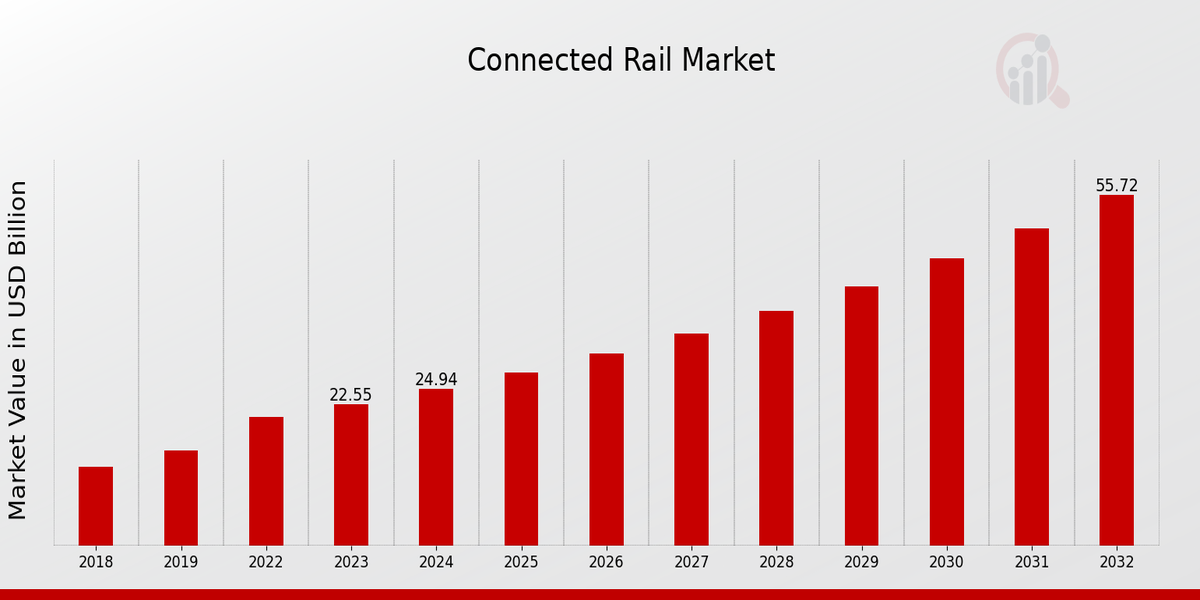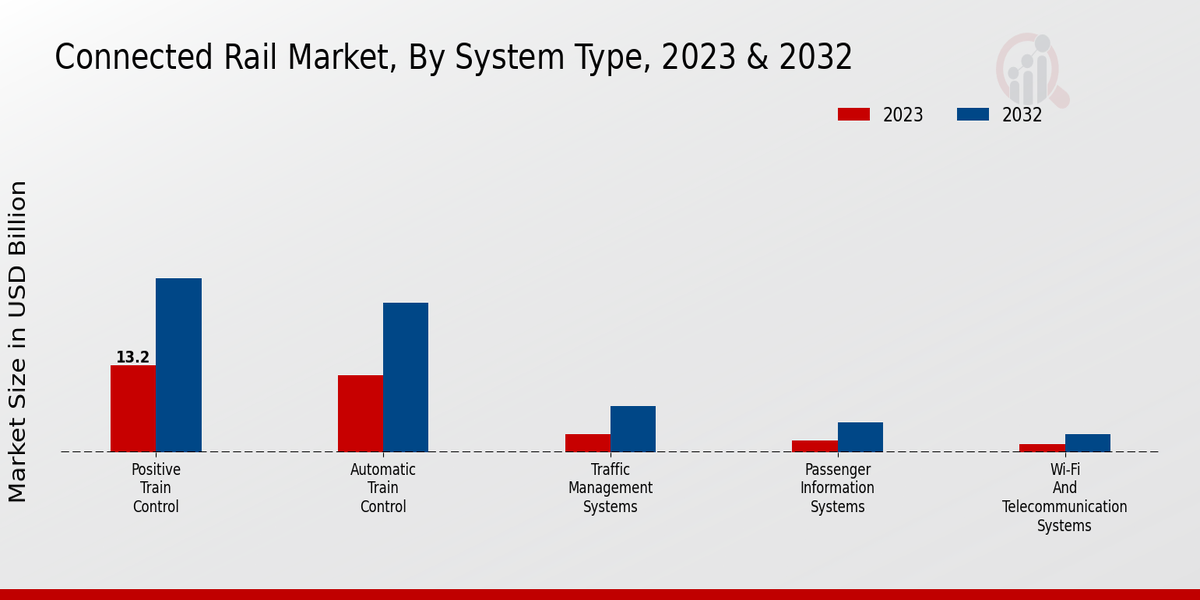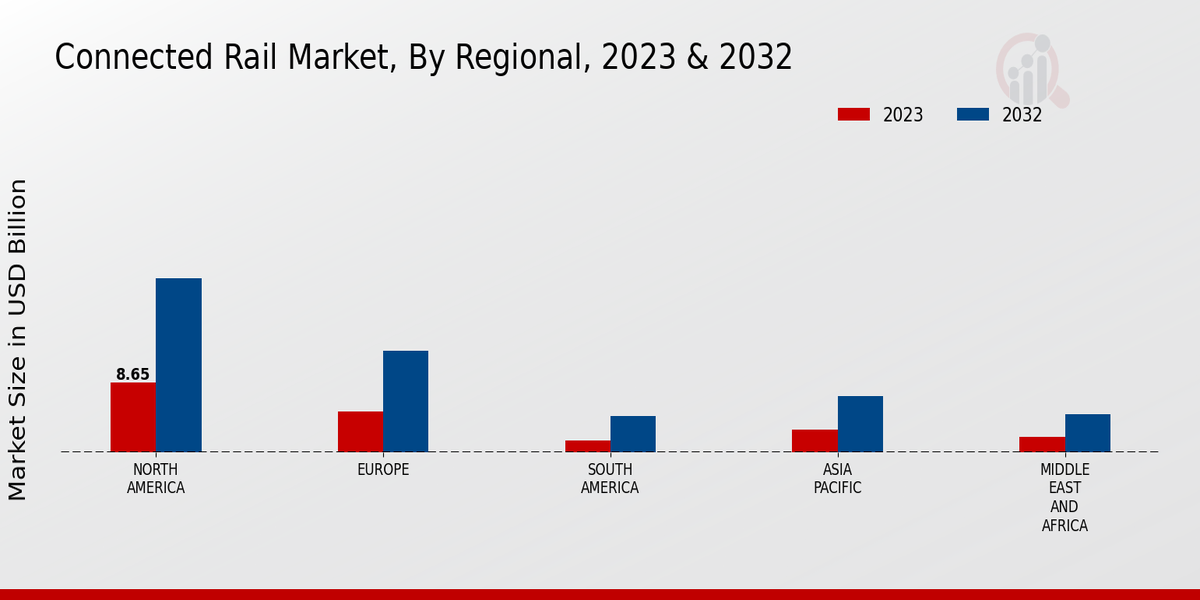Connected Rail Market Overview:
As per MRFR analysis, the connected rail market size was estimated at 20.4 (USD Billion) in 2022. The connected rail market industry is expected to grow from 22.55(USD Billion) in 2023 to 55.69 (USD Billion) by 2032. The connected rail market CAGR (growth rate) is expected to be around 10.57% during the forecast period (2024-2032).
Key Connected Rail Market Trends Highlighted
The surge in digitalization and technological advancements is driving the connected rail market, transforming the transportation landscape. The integration of sensors, data analytics, and wireless communication enables real-time monitoring, predictive maintenance, and improved operational efficiency.
Governments worldwide are prioritizing smart city initiatives, creating opportunities for the deployment of connected rail solutions. The focus on sustainability and environmental concerns is further fueling the adoption of rail transportation, making connected rail technologies crucial for enhancing efficiency and reducing emissions. Key market drivers include the need for improved safety, increased passenger experience, and optimized infrastructure management.

Source: Primary Research, Secondary Research, MRFR Database and Analyst Review
Connected Rail Market Drivers
Increasing Demand for Sustainable Transportation
The growing awareness of the environmental impact of transportation has led to an increased demand for sustainable transportation solutions. Connected rail systems offer a number of advantages over traditional transportation methods, such as reduced emissions, noise pollution, and traffic congestion. As a result, governments and businesses are increasingly investing in connected rail infrastructure, which is driving the growth of the Connected Rail Market. In addition, the rising cost of fuel is making connected rail systems more cost-effective than traditional transportation methods. This is especially true in developing countries, where the cost of fuel is often a major burden on businesses and consumers.
As a result, the demand for connected rail systems is expected to grow even faster in developing countries than in developed countries. Finally, the increasing population density in urban areas is also driving the demand for connected rail systems.As cities become more crowded, the need for efficient and reliable transportation systems becomes more important. Connected rail systems offer a number of advantages over other transportation methods, such as the ability to transport large numbers of people quickly and efficiently. As a result, connected rail systems are becoming increasingly popular in urban areas around the world.
Government Regulations and Incentives
Governments around the world are increasingly recognizing the benefits of connected rail systems and are implementing regulations and incentives to promote their development. For example, the European Union has set a goal of reducing greenhouse gas emissions by 80% by 2050. To achieve this goal, the EU is investing heavily in connected rail infrastructure. In the United States, the government has provided billions of dollars in funding for high-speed rail projects. In addition to regulations and incentives, governments are also playing a role in the development of connected rail standards. For example, the International Union of Railways (UIC) has developed a set of standards for connected rail systems. These standards are designed to ensure that connected rail systems are safe, reliable, and interoperable. The development of these standards is helping to accelerate the adoption of connected rail systems around the world.
Technological Advancements
Technological advancements are also driving the growth of the Connected Rail Market. For example, the development of new sensors and communications technologies is making it possible to create more efficient and reliable connected rail systems. In addition, the development of new train control systems is making it possible to operate trains more safely and efficiently. These technological advancements are helping to make connected rail systems more attractive to governments, businesses, and consumers.
Connected Rail Market Segment Insights:
Connected Rail Market System Type Insights
The Connected Rail Market segmentation by System Type comprises Automatic Train Control (ATC), Positive Train Control (PTC), Traffic Management Systems (TMS), Passenger Information Systems (PIS), and Wi-Fi and Telecommunication Systems. Among these, the Automatic Train Control (ATC) segment held the largest market share in 2023, accounting for nearly 35% of the Connected Rail Market revenue. This dominance is attributed to the widespread adoption of ATC systems to enhance train safety and efficiency.
Positive Train Control (PTC) is another significant segment, expected to exhibit a robust growth rate during the forecast period.Governments worldwide are increasingly mandating the implementation of PTC systems to prevent train collisions and derailments. Traffic Management Systems (TMS) play a crucial role in optimizing rail traffic flow and reducing congestion, leading to their growing adoption. Passenger Information Systems (PIS) enhance passenger experience by providing real-time train information and improve overall station operations. Wi-Fi and Telecommunication Systems enable seamless connectivity for passengers and crew, contributing to the growth of this segment.

Source: Primary Research, Secondary Research, MRFR Database and Analyst Review
Connected Rail Market Technology Insights
The Connected Rail Market is segmented by Technology into Communication-Based Train Control (CBTC), Global System for Mobile Communications - Railway (GSM-R), European Rail Traffic Management System (ERTMS), LTE-R, and 5G. The CBTC segment is expected to hold the largest market share in 2023, owing to its wide adoption in urban rail systems and its ability to improve train safety and efficiency. The GSM-R segment is expected to grow at a significant CAGR during the forecast period, due to its increasing adoption in developing countries.
The ERTMS segment is expected to witness substantial growth, driven by the increasing demand for interoperable rail systems across Europe.The LTE-R segment is expected to gain traction in the coming years, owing to its high data transmission capabilities and its ability to support real-time applications. The 5G segment is expected to emerge as a key growth driver in the long term, as it offers ultra-high bandwidth and low latency, enabling new applications and services in the rail industry.
Connected Rail Market Application Insights
The Connected Rail Market is segmented by Application into High-Speed Rail, Metro and Urban Rail, Freight Rail, Commuter Rail, Regional Rail. Among these, the Metro and Urban Rail segment is expected to hold the largest market share in 2023, accounting for over 35% of the global market revenue. This is due to the increasing urbanization and demand for efficient and sustainable transportation systems in major cities.
The High-Speed Rail segment is also expected to witness significant growth over the forecast period, driven by government initiatives to improve intercity connectivity and reduce travel time.The Freight Rail segment is expected to grow steadily, supported by the increasing demand for efficient and reliable freight transportation services. The Commuter Rail and Regional Rail segments are also expected to contribute to the overall growth of the Connected Rail Market.
Connected Rail Market End-User Insights
The Connected Rail Market is segmented into various end-user segments, including Railways, Transit Authorities, Private Rail Operators, Maintenance and Service Providers, Passenger and Freight Operators. Among these, Railways accounted for the largest share of the Connected Rail Market revenue in 2023, and this trend is expected to continue during the forecast period. This dominance can be attributed to the increasing adoption of connected rail technologies by railway operators worldwide to improve operational efficiency, enhance passenger safety, and optimize resource utilization.For instance, in 2023, Deutsche Bahn, the German national railway company, announced plans to invest $1 billion in digitalization and connectivity initiatives over the next five years.
Connected Rail Market Regional Insights
The Connected Rail Market segmentation by region offers insights into key regional markets and their contribution to the overall market growth. North America held the largest revenue share in 2023 and is expected to maintain its dominance throughout the forecast period. The region's well-established rail infrastructure, government initiatives to promote rail connectivity, and growing adoption of advanced technologies drive its growth.
Europe is another major market, with a significant focus on sustainable and efficient rail transportation.APAC is expected to witness the highest growth rate during the forecast period due to rapid urbanization, increasing investment in rail infrastructure, and government initiatives to modernize rail networks. South America and MEA are emerging markets with growing potential for connected rail solutions as they seek to improve their rail infrastructure and enhance connectivity.

Source: Primary Research, Secondary Research, MRFR Database and Analyst Review
Connected Rail Market Key Players and Competitive Insights:
Major players in the connected rail market are continuously enhancing their position in the market by improving their existing offerings and introducing new innovative solutions. Leading connected rail market players are focusing on strategic collaborations, acquisitions, and partnerships to expand their market presence and strengthen their product portfolio.
The connected rail market development is driven by the increasing adoption of digital technologies and the growing demand for enhanced safety, efficiency, and reliability in rail operations. The competitive landscape of the Connected Rail Market is characterized by the presence of both established players and emerging startups.
A leading company in the connected rail market is Siemens. The company offers a comprehensive portfolio of connected rail solutions, including signaling systems, communication systems, and traffic management systems.
Siemens has a strong global presence and a proven track record of delivering innovative solutions to the rail industry. The company is actively involved in research and development activities to enhance its product offerings and stay ahead of the competition. Siemens has a strong focus on customer satisfaction and provides tailored solutions to meet the specific needs of its customers.
A competitor company in the connected rail market is Alstom. The company offers a broad range of connected rail solutions, including train control systems, passenger information systems, and traction systems.
Alstom has a global presence and a strong track record of delivering reliable and efficient solutions to the rail industry. The company is committed to innovation and continuously invests in research and development to enhance its product offerings. Alstom has a strong focus on sustainability and provides environmentally friendly solutions to its customers.
Key Companies in the Connected Rail Market Include:
- Bombardier Transportation
- Kawasaki Heavy Industries
- CSR Zhuzhou Electric Locomotive
Connected Rail Market Developments
The connected rail market is projected to reach USD 55.69 billion by 2032, exhibiting a CAGR of 10.57% during the forecast period (2024-2032). Rising urbanization, increasing demand for efficient transportation systems, and government initiatives to promote sustainable mobility are driving market growth.
Recent developments in the market include the launch of new connected rail solutions, such as smart trains and intelligent rail networks. These solutions offer enhanced safety, operational efficiency, and passenger convenience. Additionally, the integration of IoT sensors and data analytics is enabling real-time monitoring and predictive maintenance, further driving market growth.
Key players in the market are investing in research and development to enhance their product offerings. For instance, in 2023, Siemens Mobility announced the launch of its next generation signaling system, Trainguard MT, which utilizes advanced technology to improve safety and reliability.
Connected Rail Market Segmentation Insights
Connected Rail Market System Type Outlook
-
- Automatic Train Control (ATC)
- Positive Train Control (PTC)
- Traffic Management Systems (TMS)
- Passenger Information Systems (PIS)
- Wi-Fi and Telecommunication Systems
Connected Rail Market Technology Outlook
-
- Communication-Based Train Control (CBTC)
- Global System for Mobile Communications - Railway (GSM-R)
- European Rail Traffic Management System (ERTMS)
- LTE-R
- 5G
Connected Rail Market Application Outlook
-
- High-Speed Rail
- Metro and Urban Rail
- Freight Rail
- Commuter Rail
- Regional Rail
Connected Rail Market End-User Outlook
-
- Railways
- Transit Authorities
- Private Rail Operators
- Maintenance and Service Providers
- Passenger and Freight Operators
Connected Rail Market Regional Outlook
-
- North America
- Europe
- South America
- Asia Pacific
- Middle East and Africa
| Report Attribute/Metric |
Details |
| Market Size 2022 |
20.4 (USD Billion) |
| Market Size 2023 |
22.55 (USD Billion) |
| Market Size 2032 |
55.69 (USD Billion) |
| Compound Annual Growth Rate (CAGR) |
10.57% (2024-2032) |
| Report Coverage |
Revenue Forecast, Competitive Landscape, Growth Factors, and Trends |
| Base Year |
2023 |
| Market Forecast Period |
2024 - 2032 |
| Historical Data |
2019 - 2023 |
| Market Forecast Units |
USD Billion |
| Key Companies Profiled |
Siemens Mobility., Bombardier Transportation., Kawasaki Heavy Industries., Ansaldo STS., Stadler Rail., General Electric., Hyundai Rotem., Hitachi Rail., Toshiba., CSR Zhuzhou Electric Locomotive., Wabtec., Alstom., CRRC Corp., Mitsubishi Electric. |
| Segments Covered |
System Type, Technology, Application, End-User, Regional |
| Key Market Opportunities |
Key Market Opportunities in Connected Rail MarketPredictive maintenance reducing downtime Enhanced passenger experience realtime updates Optimized freight operations efficiency gains Cybersecurity ensuring data privacy and protection Smart infrastructure optimizing rail network performance |
| Key Market Dynamics |
Increased demand for remote monitoring Growing investment in rail infrastructure Advancements in IoT and sensor technologies Government initiatives for smart rail Integration of AI and machine learning |
| Countries Covered |
North America, Europe, APAC, South America, MEA |
Frequently Asked Questions (FAQ) :
The Connected Rail Market is estimated to be valued at 22.55 billion USD in 2023.
The Connected Rail Market is projected to reach a valuation of 55.69 billion USD by 2032.
The Connected Rail Market is expected to grow at a CAGR of 10.57% from 2024 to 2032.
The Asia-Pacific region is expected to dominate the Connected Rail Market throughout the forecast period.
Key applications of Connected Rail technology include predictive maintenance, remote monitoring, passenger information systems, and automated train operations.
Key competitors in the Connected Rail Market include Siemens, Alstom, Bombardier, Hitachi, and Thales.

















